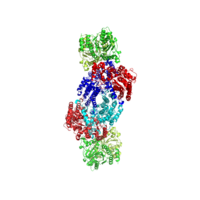
Photo from wikipedia
The protozoan Plasmodium falciparum is the main aetiological agent of tropical malaria. Characteristic of the phylum is the presence of a plastid-like organelle which hosts several homologs of plant proteins,… Click to show full abstract
The protozoan Plasmodium falciparum is the main aetiological agent of tropical malaria. Characteristic of the phylum is the presence of a plastid-like organelle which hosts several homologs of plant proteins, including a ferredoxin (PfFd) and its NADPH-dependent reductase (PfFNR). The PfFNR/PfFd redox system is essential for the parasite, while mammals share no homologous proteins, making the enzyme an attractive target for novel and much needed antimalarial drugs. Based on previous findings, three chemically reactive residues important for PfFNR activity were identified: namely, the active-site Cys99, responsible for hydride transfer; Cys284, whose oxidation leads to an inactive dimeric form of the protein; and His286, which is involved in NADPH binding. These amino acid residues were probed by several residue-specific reagents and the two cysteines were shown to be promising targets for covalent inhibition. The quantitative and qualitative description of the reactivity of few compounds, including a repurposed drug, set the bases for the development of more potent and specific antimalarial leads.
Journal Title: Biochemical and biophysical research communications
Year Published: 2021
Link to full text (if available)
Share on Social Media: Sign Up to like & get
recommendations!